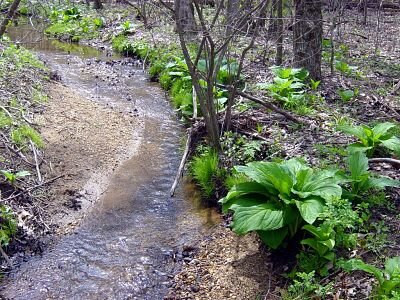The strange life of the skunk cabbage
/The strange, hooded flower of the skunk cabbage. — Muffet/Creative Commons
While we scan the garden for snowdrops and the crocuses -- the pretty little things that herald a new season -- something strange is afoot in wet woodlands where the wild things are.
Skunk cabbage is a creature of such places, growing along (and even in) the freshwater streams of New Jersey, including the one that marks the rear boundary of my property. Just the other day, I found them emerging from the cold, wet mud under the leafless trees. Sometimes a sharply pointed cone, sometimes spiraled at the tip, the mottled-brown spathes are gnome-like and enigmatic.
Once fully out of the soil, the pointed spathe splits to reveal what looks like a spongy, studded golf ball -- really a round spadix scattered with tiny, ill-smelling florets. The stink is meant to attract pollinating gnats and flies that have been hibernating under dead leaves, luring them with a vaguely carrion-like aroma they apparently find hard to resist.
The whole apparatus looks a bit alien, especially when it emerges through a dusting of snow or a skim of ice. The plant can pull this off because it is, in a sense, warm-blooded. By oxidizing starches stored in its roots, the skunk cabbage can raise and maintain temperatures as high as 60 degrees in its hood-like spathe even when the air is below freezing. (Only the sacred Asian lotus shares this endothermic trait — make of that what you will.)
Is it too far-fetched to imagine that this plant’s strange ways have struck others as other-worldly? The sci-fi novelist Robert Heinlein in “Red Planet” imagined an enormous heat-generating desert cabbage that sheltered some of the first human visitors (Jim and Frank) from the cold Martian night:
“The far edges of the plant lifted and began to curl toward them ... a leaf, four feet wide at its widest and at least 10 feet long, raised up in back of Jim and curved in until it touched his shoulder. The leaves closed down on them, seemed to feel them out, then settled firmly against them. Soon the last open space was covered and they were in total darkness.”
Skunk cabbage in its native habitat. -- Martin LaBar/CC
Well, here on Earth, bees and spiders sometimes seek shelter from the cold in the spathe’s depths, just as Frank and Jim did. Frogs and lizards hide beneath the leaves and a type of warbler, the yellowthroat, sometimes nests in them, using the plant’s foul odor to mask its scent.
Insects and mammals are sensitive to the smell but humans, not so much. If you put your nose to the spathe and nestled it close to the inner “golf ball”, you might detect a pungent, skunky odor. Some say this smell can waft out into the air, but I can’t say that I’ve noticed it and I’ve lived with skunk cabbage for a long time.
The smelly reputation of this plant is chiefly founded on the rank odor released when the leaves are crushed or torn, a warning to would-be grazers. In fact, the leaves, which emerge after the spathe disintegrates, contain a compound called calcium oxalate that causes a burning pain and swelling in the mouths of nibblers. The upside: deer and rabbits don’t touch skunk cabbage despite its resemblance to a hosta on steroids.
Don’t think that you might dig up a mature skunk cabbage and transplant it to your backyard bog garden as this will almost surely prove futile. As another active defense, this plant has contractile roots, i.e., underground shoots that contract after piercing the earth, drawing the plant deeper and ever downward. Firmly anchored in the muck, skunk cabbages can persist for many years and resist all attempts to dislodge them.
Despite its noxious qualities, Native Americans and contemporary herbalists have used skunk cabbage in concoctions they claim are beneficial. My favorite New Age application is the use of skunk cabbage “essence” in aromatherapy. Allegedly, one sniff can “pierce the shell of stagnant mental attitudes,” bringing fresh new currents of inspiration.
Well, maybe. I prefer to just chalk skunk cabbage up to nature’s own inspired inventiveness. Anything that can be, is…somewhere.


